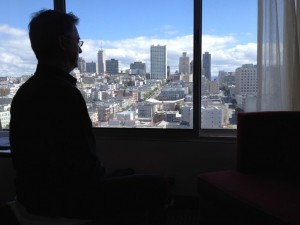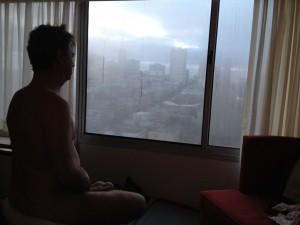Teisho held in Wageningen on April 7, 2013

Shi kan ta za 只管打坐
Sitting (za) totally (kan) with the (ta) heart/mind (shi) is a Soto-Zen expression for deep meditation. Originally the first person bringing Zen from China to Japan was Myōan Eisai (明菴栄西, May 27, 1141 – July 2, 1215). At that point in time Buddhism was already several 100 years in Japan. But it was mainly the nobility that adhered to it. Eisai had been taught Ch’an Buddhism in the Lin Chi school. Japanese cannot pronounce the L so they make it into an R, and pronounced Lin Chi as Rinzai. At that point in time the samurai class was an upcoming economic and political force. So the samurai wanted to distinguish themselves from the normal people by taking on Buddhism as well. And lo and behold there was the new Rinzai Buddhism they could embrace. The emperor agreed and declared Rinzai the official school for Zen Buddhism in Japan. The samurai did a good job inculcating their martial life style into their Rinzai Zen Buddhism.
Dōgen
It is only a little over a decade later (1228) that Dōgen Zenji (道元禅師; also Dōgen Kigen 道元希玄, or Eihei Dōgen 永平道元, or Koso Joyo Daishi) (19 January 1200 – 22 September 1253) arrived in Japan bringing the Sōtō school of Zen from China. The central theme of his practice was “sitting in zazen is the expression of complete awakening”. All monks that had undertaken the arduous trip from Japan to China and back, had carried many manuscripts and holy relics with them to proof their learnedness. Dōgen had not taken anything but his clothes and his body back. He was convinced the whole of Japan was waiting for his revelations. But the first thing he heard was that while he had been away, the emperor had bestowed his imperial seal on the competing Rinzai school. When challenged by other monks to show what he had learned in China he answered: “The nose is vertical, the eyes are horizontal”. But it is his influence that made zazen such a central practice in Japanese Zen. He wrote his philosophical and religious insights down in a treatise of 95 chapters called the Shōbōgenzō. In everything he stretched the inseparability of practice and awakening and thus stressed the practice of Shikantaza. It is especially his influence that gave us here in the West the impression that Zen is only about sitting in meditation. It is not however, many rituals and sutras play an important role in the daily life of the Zen priest.
Rituals
When I went to my first sesshin with a ‘real’ Japanese Zen master (Tetsuo Kiichi Nagaya Roshi) in 1977 I was struck by the abundance of rituals we had to perform. It is only later I found out that these were only a mere subset of rituals that were actually occurring in Zen monasteries. In the beginning you have to really concentrate to do everything in the right order and precisely as described. However if you persist and become familiar with these rituals, they suddenly become a support. It is as if they carry you into a position that Samadhi can continue even when you are not sitting on your cushion. But I especially remember fondly the little prayer we were supposed to say before sitting down at the dinner table (oryoki style eating came much later). It went more or less like this: “We are thoughtful of all the efforts that have been done to bring forth this food. And we eat not because we crave it, but because we want to become strong in order to be able to help all the needy beings in this world.” And so I became familiar with the central theme of the Avatamsaka sutra, namely that compassion is the essence of meditation.
Equilibrium

Because of all the rituals and the long hours of motionless sitting in zazen each day, I slowly descended into a state of quietness and alertness. I still remember I was sitting and suddenly there was a sound like an explosion right outside of the zendo. It was as if the sound moved right through me without any hindrance. Both body and mind remained perfectly still, but there was complete awareness of the sound and its movement. I also noticed an heightened sense of equilibrium. As I was standing on one foot to put on a sock, I noticed not the slightest tremor or involuntary movements to keep my balance. Tetsuo Nagaya Roshi was a very famous and gifted calligraphist and he gave me two calligraphies he made there on the spot. One is the classical character Mu from the famous first koan of the Mumonkan (Wu men guan in Chinese). And the other is Shi Kan Ta Za, both I have had hanging in my living room ever since.
Individuation and letting go
But the main question now is: “What is Shi Kan Ta Za?” Dōgen is very clear about this, in his Fukanzazengi he states: “When you take a short breath, you know that you take a short breath. When you take a long breath, you know that you take a long breath.” That is the essence of Shikantaza. Sounds simple hey! I once heard a Zen master say that it takes a monk 15 years of intense practice before he can do Shikantaze at will. Shikantaza is not that difficult to do, actually it is quite simple. The trick is that you cannot do it. You have to learn to let go and allow Shikantaza to do it to you. And that takes usually a long time. But that is not for everybody so. Life can be a bitch and suffering can be douched on you by the truckloads. If you can somehow endure this without closing yourself of from reality, then Shikantaza goes much faster. Why would this be so? Well we here in the West are suffering from something that started out as a blessing, but turned into a little monster on the way. And that is our individuation. We became individuals responsible for our own lives and open to the possibility of possibilities. However this fostered our narcissism as well. We are now brought up with the idea that we create our own life and that if disaster strikes we have only ourselves to blame. And the result is that we blame ourselves all the time. And when we sit in meditation and our mind frets about, we start blaming ourselves that we are not doing it right. It is very difficult for us to accept that we cannot create this condition called Shikantaza. And that’s where the rituals come in. By performing the rituals with the utmost precision there is at least something we can do right. We can lose ourselves in that precision and so learn to let the rituals perform themselves. At a certain point we let our meditation perform itself and then there is Shikantaza!
Let the bottom fall out
Start by saying to yourself that you are not sitting for yourself, not to improve yourself, nor to become more beautiful. But you are sitting because you can’t stand the suffering in the world. You see the millions of children suffering in Syria and the surrounding camps. You can send money, that will help. But if you really want to free these people of suffering you sit for them. And light the fire of desire. Make sure you wish all the suffering to disappear from the world. And sit with that fire. That is what the Buddha did. He was an ordinary human being, so are you. So sit with every fibre you got and demand the impossible, i.e. a world free from these horrors as they occur in Syria, Central Africa, Myanmar and even in the house next door where somebody lay dead for 10 years before anyone noticed. Be prepared to offer your life for this request, that no more suffering shall occur. The bottom will fall out of you and reality will be turned inside out. Only afterwards you will know: That was Shikantaza!
When Dōgen Zenji died he wrote this poem on his death bed:
Fifty-four years lighting up the sky.
A quivering leap smashes a billion worlds.
Hah!
Entire body looks for nothing.
Living, I plunge into Yellow Springs.
